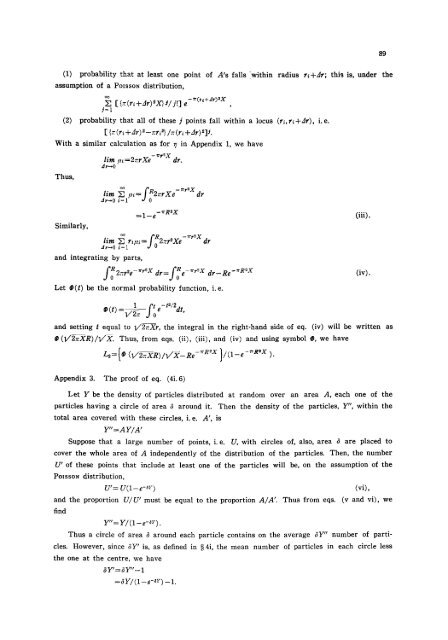A comparative study of models for predation and parasitism
A comparative study of models for predation and parasitism
A comparative study of models for predation and parasitism
You also want an ePaper? Increase the reach of your titles
YUMPU automatically turns print PDFs into web optimized ePapers that Google loves.
(1)<br />
assumption <strong>of</strong> a PoxssoN distribution,<br />
~E [ {z (r, + Jr)'Aq s~ j!] e - ~'(' '+ dr)2X ,<br />
j~l<br />
(2) probability that all <strong>of</strong> these j points fall within a locus (ri, ri+dr), i.e.<br />
[ {z (r~ +dr) 2_ r, ri~}/~r (ri +dr) 2],,.<br />
With a similar calculation as <strong>for</strong> 7] in Appendix 1, we have<br />
Thus,<br />
Similarly,<br />
probability that at least one point <strong>of</strong> A's falls within radius ri+dr; this is, under the<br />
l. - wr~.X<br />
~m ta~=2~rXe dr.<br />
d r--*O<br />
co PR - *rr2X<br />
lira i=<br />
J r--~0 '=<br />
a~lFi=|o 2r, rXe dr<br />
=l_e-~rR~X<br />
oo PR ~ -wrO-X<br />
lira ]E rq2~=l 2.'rr Xe dr<br />
zIr~O i=1 dO<br />
<strong>and</strong> integrating by parts,<br />
(iii).<br />
fR2~,r,e-,rrO~X, ar=Jo ['R-wr~<br />
e ' dr-Re -'R~'x (iv).<br />
Let O(t) be the normal probability function, i.e.<br />
1 t - t 2/2<br />
$(t) =. 7,-- f e dt,<br />
V~Tr JO<br />
<strong>and</strong> setting t equal to l/2zXr,<br />
9 (1/~R)/V'X.<br />
the integral in the right-h<strong>and</strong> side <strong>of</strong> eq. (iv) will be written as<br />
Thus, from eqs. (ii), (iii), <strong>and</strong> (iv) <strong>and</strong> using symbol ~, we have<br />
L.=[, )<br />
89<br />
Appendix 3. The pro<strong>of</strong> <strong>of</strong> eq. (4i. 6)<br />
Let Y be the density <strong>of</strong> particles distributed at r<strong>and</strong>om over an area A, each one <strong>of</strong> the<br />
particles having a circle <strong>of</strong> area 6 around it. Then the density <strong>of</strong> the particles, Y", within the<br />
total area covered with these circles, i.e. A', is<br />
Y"-=-AY/A'<br />
Suppose that a large number <strong>of</strong> points, i.e. U, with circles <strong>of</strong>, also, area ~ are placed to<br />
cover the whole area <strong>of</strong> A independently <strong>of</strong> the distribution <strong>of</strong> the particles. Then, the number<br />
U' <strong>of</strong> these points that include at least one <strong>of</strong> the particles will he, on the assumption <strong>of</strong> the<br />
Poissos distribution,<br />
U'= U(1-e -~r)<br />
(vi),<br />
<strong>and</strong> the proportion U/U ~ must be equal to the proportion A/A'. Thus from eqs. (v <strong>and</strong> vi), we<br />
find<br />
Y"=Y/(1-e-~Y).<br />
Thus a circle <strong>of</strong> area c~ around each particle contains on the average 6Y~P number <strong>of</strong> particles.<br />
However, since ~Y~ is, as defined in w 4i, the mean number <strong>of</strong> particles in each circle less<br />
the one at the centre, we have<br />
6Y'=6Y"--I<br />
=~Y/(1-e -~r) -1.















